#fhir interoperability
Explore tagged Tumblr posts
Text

FHIR stands for Fast Healthcare Interoperability Resources. The main functionality of FHIR is to elaborate data formats, resources, and an app programming interface for the prevailing EHR. By letting us integrate the FHIR interoperability into your app, we offer some great features during the entire process. So you need not look back and rest assured of the massive growth of your healthcare business.
#smart on fhir#fhir interoperability#fhir integration#smart fhir#fhir software#smart on fhir applications#smart on fhir integration
0 notes
Text
Fhir Interoperability UK
Join the data exchange revolution with FHIR interoperability. Seamlessly connect systems, streamline workflows, and revolutionize care coordination.
0 notes
Text

Transform healthcare with JK Tech's expert FHIR (Fast Healthcare Interoperability Resources) services. Seamlessly integrate patient data, streamline healthcare workflows, and enhance interoperability with our FHIR interoperability solutions. Revolutionize healthcare data exchange, improving patient care and data security. Elevate your IT infrastructure with JK Tech's FHIR expertise, leading the way in healthcare innovation.
0 notes
Text
2 notes
·
View notes
Text
https://www.clindcast.com/
#healthcare#healthcareconsulting#florida#healthcare it consulting#healthcareit#fhir#interoperability#ehr#electronic health record
3 notes
·
View notes
Text
HL7 Platforms Explained: The Backbone of Healthcare Communication Standards
In today's fast-changing healthcare environment, a healthcare interoperability solution is essential for seamless communication among various medical systems. Hospitals, labs, clinics, and other healthcare providers use many different software applications, devices, and data formats. Without a proper system to connect these, sharing important patient information can become slow, incomplete, or error-prone. This is where HL7 platforms come in as the foundation for making healthcare data flow smoothly and securely.
HL7 platforms are the key technology behind many healthcare interoperability solutions used worldwide. They help different healthcare systems “talk” to each other using common standards, enabling better coordination of care. In this blog, we will explain what HL7 platforms are, why they matter, and how they support modern tools like FHIR compliant interoperability software. We will also show how healthcare organizations benefit by adopting these platforms.

What is an HL7 Platform?
An HL7 platform is a software framework or tool that supports the HL7 standard for healthcare data exchange. HL7 stands for Health Level Seven, which is a set of international standards that define how health information is packaged and shared between computer systems.
These platforms act as translators and routers. They take medical data from one system, convert it into a common HL7 format, and then send it to another system that understands that format. This process allows different applications — such as electronic health records (EHRs), lab systems, and billing software — to exchange information accurately and quickly.
By using an HL7 platform, hospitals and clinics reduce the need for manual data entry, lower errors, and speed up patient care.
Why Are Healthcare Interoperability Platforms Important?
Healthcare is complex, with many stakeholders involved. Different departments and providers often use different software systems. Without a healthcare interoperability solution, these systems work in isolation, which can cause delays and miscommunication.
Healthcare interoperability platforms help solve this problem by connecting systems and enabling them to share data in real time. They improve patient safety by giving doctors access to complete medical histories, test results, and medication lists without delay. This better communication also cuts costs by avoiding duplicate tests and unnecessary procedures.
Moreover, interoperability platforms help healthcare providers meet regulatory requirements for data sharing and privacy. They build trust by ensuring patient information is exchanged securely and only with authorized parties.

How HL7 Platforms Work with FHIR Compliant Interoperability Software
In recent years, HL7 introduced a newer standard called FHIR (Fast Healthcare Interoperability Resources). FHIR simplifies healthcare data exchange by using modern web technologies such as RESTful APIs and JSON/XML formats. This makes integration faster and easier compared to older HL7 versions.
Many healthcare organizations are now adopting FHIR compliant interoperability software alongside traditional HL7 platforms. This software supports both the HL7 standards and FHIR, providing a flexible way to connect new and legacy systems.
HL7 platforms play a vital role in bridging older systems that use classic HL7 messaging with modern applications designed for FHIR. This combined approach helps healthcare providers gradually upgrade their technology without disrupting patient care.
Benefits of Using HL7 Platforms in Healthcare
Using HL7 platforms as part of a healthcare interoperability solution offers several key benefits:
1. Seamless Data Exchange
HL7 platforms ensure smooth and standardized data flow between different healthcare systems, allowing accurate and timely access to patient information.
2. Enhanced Patient Care
Better data sharing leads to improved diagnosis and treatment decisions. Clinicians have full medical histories and test results at their fingertips.
3. Cost Savings
By reducing duplicated tests and manual paperwork, HL7 platforms lower administrative costs and reduce delays in patient care.
4. Regulatory Compliance
These platforms help meet health data exchange regulations and maintain patient privacy by controlling data access and sharing.
5. Support for New Technologies
HL7 platforms work with FHIR and other modern standards, enabling healthcare providers to adopt innovative digital health tools without starting from scratch.
How Helixbeat Supports Your Healthcare Interoperability Needs
Helixbeat offers advanced healthcare interoperability platforms designed to help organizations manage and exchange health data effectively. With our expertise in FHIR compliant interoperability software, we deliver solutions that connect your existing systems and new digital tools.
Our platforms provide secure, scalable, and easy-to-use interfaces that improve collaboration across healthcare teams. Whether you are implementing HL7 messaging or transitioning to FHIR, Helixbeat’s solutions can adapt to your needs.
Contact us today to learn how Helixbeat can help your organization build a robust healthcare interoperability solution that improves patient outcomes and operational efficiency.

FAQs About HL7 Platforms and Healthcare Interoperability
1. What is the main purpose of an HL7 platform?
An HL7 platform standardizes and manages the exchange of healthcare information between different software systems to improve communication and patient care.
2. How does FHIR relate to HL7?
FHIR is a modern standard developed by HL7 that uses web technologies for faster and easier healthcare data exchange compared to older HL7 versions.
3. Why is healthcare interoperability important?
Interoperability allows different healthcare systems to share patient data efficiently, improving care quality, reducing errors, and cutting costs.
4. Can HL7 platforms work with existing hospital software?
Yes, HL7 platforms are designed to integrate with many legacy systems as well as new healthcare applications, enabling smooth data exchange.
5. How does Helixbeat support healthcare interoperability?
Helixbeat provides scalable and secure interoperability platforms, including FHIR compliant software, that connect diverse healthcare systems seamlessly.
#electronic health record systems#electronic medical records software#FHIR compliant interoperability software#healthcare interoperability platforms#hl7 platform
0 notes
Text
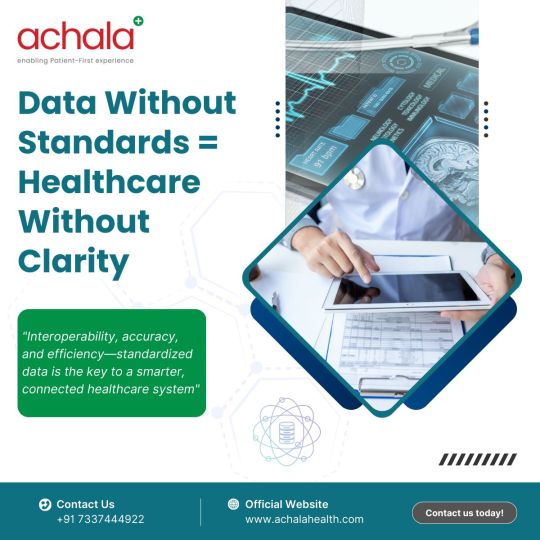
Unlocking the Power of Data in Indian Healthcare!
Healthcare without data standards is like a puzzle with missing pieces—disconnected, inefficient, and error-prone. Standardized data ensures seamless information exchange, faster diagnoses, and smoother insurance processing.
🔹 Interoperability: Break silos & connect systems effortlessly 🔹 Better Patient Care: Real-time, accurate medical records 🔹 Compliance & Security: Adhering to ABDM, FHIR & HL7
At Achala Health Services Private Limited, we’re making healthcare smarter & more connected with AI-driven solutions. Is your system ready for the future? 🔗 Read more: https://lnkd.in/gNnGqTYn
#DataStandards#HealthcareInnovation#DigitalHealth#AchalaHealth#abdm#HealthTech#Interoperability#FHIR#HL7#EHR#AyushmanBharat#ABDM#HealthForAll#MedTechIndia#HealthcareTransformation#BetterPatientCare#ConnectedHealthcare#SmartHospitals#HealthDataExchange#AIinHealthcare
0 notes
Text
Medical Practices Need to Embrace Two-Way Texting and AI

Let's face it, calling your doctor's office can be an exercise in frustration. Long hold times, automated menus, and the dreaded elevator music...it's enough to make anyone lose their cool. But what if there was a better way?
Here's the truth: traditional voice-only medical practices are outdated. Patients shouldn't have to waste precious time on hold for simple tasks like scheduling appointments, refilling prescriptions, or paying bills. This outdated system creates a frustrating experience for everyone involved. Patients are left feeling unheard and unimportant, while overwhelmed front desk staff struggle to keep up with the constant ringing.
There's a better way. Medical practices can leverage technology to offer a more convenient and efficient experience for patients. Here's how:
Embrace two-way texting: Texting is the dominant communication method today. Studies show a 95% open rate for text messages, meaning patients are far more likely to see and respond to a text than answer a call. Two-way texting allows for real-time conversations, streamlining communication for both patients and staff. Practices can leverage this technology to:
Schedule appointments
Refill prescriptions
Send directions to the office location
Answer basic questions
Send appointment reminders and confirmations
Collect patient feedback
The good news? You don't have to ditch your existing phone number! Text-enabling technology allows you to seamlessly integrate texting with your current office phone line. This means patients can still reach you at the familiar number they know, but with the added convenience of texting.
Smarter texting with AI: Instead of a clunky AI chatbot, a smarter texting solution powered by AI can assist both staff and patients. This AI assistant can:
Understand natural language: No more robotic responses! The AI can understand the intent behind a patient's text message, allowing for a more natural and efficient conversation.
Provide automated responses: The AI can handle frequently asked questions and basic tasks like appointment confirmations, prescription refill reminders, and insurance updates.
Route complexities to staff: For more complex inquiries, the AI can seamlessly route the conversation to a staff member, ensuring all patient needs are met.
But it doesn't stop there. Here's what a winning texting solution should offer:
EHR integration: A seamless integration with your Electronic Health Record (EHR) ensures all patient information is readily available for a smooth texting experience.
Worklist management: An easy-to-use interface allows front office staff to manage their workload efficiently, prioritize messages, and collaborate with the AI assistant for faster responses.
By implementing these technologies, medical practices can:
Reduce hold times: No more waiting on hold! Patients can handle routine tasks quickly and efficiently.
Improve patient satisfaction: A more convenient experience leads to happier patients.
Increase staff efficiency: Freeing up staff from constant phone calls allows them to focus on more complex tasks and patient care.
The time for change is now. Let's ditch the outdated phone-only system and embrace a more patient-centric approach. Two-way texting with the help of an AI assistant offers a future where medical care is convenient, efficient, and puts the patient first.
Ready to transform your patients' experience? Contact us for more information.
0 notes
Text
2024: The Dawn of Interconnected Healthcare

Envision a world where medical records seamlessly traverse between hospitals, medical practices, and pharmacies, guiding care decisions. Healthcare's future shines bright in 2024, illuminated by three major trends poised to revolutionize how we experience and deliver health: interoperability, revenue cycle management (RCM) optimization, and empowered patient engagement.
Interoperability
The longstanding aspiration of unlocking healthcare data is finally becoming a reality. After years of anticipation, 2023 witnessed the momentous launch of the nationwide data exchange powered by TEFCA (Trusted Exchange Framework and Common Agreement). This landmark framework acts as a key, unlocking data silos and allowing medical records to flow freely across different healthcare systems nationwide. This unprecedented data liberation promises to harmonize care coordination, drastically reducing medical errors and eliminating redundant tests. The future of healthcare looks brighter than ever, with patients empowered to actively participate in their own journey by easily accessing their complete medical picture across disparate providers.
RCM Evolution
Picture cloud-based RCM platforms powered by AI automation, where bills are personalized, claims processed seamlessly, and denials tackled proactively. We are well on the path to realizing this vision. According to a recent survey conducted by Change Healthcare, 98% of healthcare leaders across the US plan to leverage AI across their revenue cycle within the next three years. This aligns with several other studies from organizations like HFMA and NBER, all highlighting the rising adoption of AI for tasks like automated claims processing, personalized billing, and proactive denial management. This growing focus on AI-powered RCM is fueled by its potential to support value-based care models, where providers are rewarded for improved patient outcomes rather than just the number of procedures performed.
Patient Engagement, Redefined
With virtual care models taking center stage, AI advances like Google’s PaLM2 and others are fueling a patient-centric healthcare revolution. Robust language models tailor interventions, while intelligent assistants handle appointments and provide real-time support. The healthcare landscape is transitioning from hospital to the comfort of our homes, empowered by convenient virtual consultations and remote monitoring.
Beyond the Horizon
This glimpse into the healthcare landscape of 2024 is just the first act. Picture wearable sensors feeding real-time health data into AI-powered models that predict and prevent illnesses. The possibilities are limitless, driven by ongoing technological advancements and an unwavering commitment to patient-centered care.
So, buckle up. We stand on the precipice of a transformative era where data intertwines with innovation, finances align with outcomes, and patients rightfully take center stage in their well-being. The future of healthcare is not merely interconnected – it's genuinely human-centric, and 2024 is only the beginning.
Ready to make this journey easier? Reach out to Falkondata and discover how we can streamline your process and achieve your goals.
#ehr#future of healthcare#health and wellness#AdvancedMD#Falkondata#interoperability#EHR Integration#FHIR#health tech#patient care#medical billing services#healthcare industry#hl7
0 notes
Text
https://www.clindcast.com/key-regulatory-changes-impacting-healthcare-in-2023/
#healthcare#healthcare it#regulatory#healthcareconsulting#consulting#itconsulting#ehr#fhir#interoperability
0 notes
Text

HL7 FHIR Interoperability Specialist-Nashville, TN (Hybrid) Apply SohanIT Inc Jobs on #JobsHorn: https://jobshorn.com/job/hl7-fhir-interoperability-specialist/7425 12+ Months| 10+Yrs| C2C/W2 Interview Type: Skype or Phone
JD: *FHIR implementation experience and FHIR interface work with public health or clinical information systems. *Familiarity with electronic data interchange (EDI) EDI engines such as Rhapsody.
Contact: [email protected] |+1 470-410-5352 EXT:111
#hl7 #fhir #hl7fhir #Tennessee
#usajobs#contractjobs#recruiters#recruitment#jobshorn#opportunities#hiring#career#urgent_hiring#itjobs
4 notes
·
View notes
Text
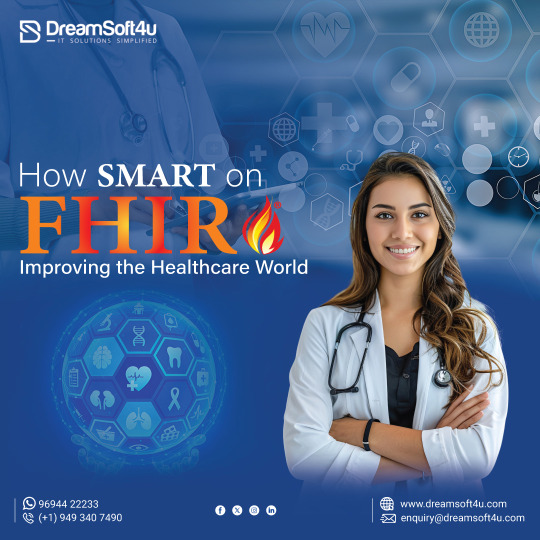
SMART on FHIR is an extension of FHIR in that it creates a structure for applications that can articulate with a range of healthcare systems. SMART aims to innovate healthcare applications that will enable interoperability and usability. Also, the SMART framework consists of guidelines and tools for developing interchangeable and modular applications that work in various contexts of the healthcare domain. This way, applications developed with the help of SMART on FHIR can function in different contexts without significant adjustments.
0 notes
Text
Fhir Interoperability USA
Unlock the potential of FHIR interoperability for seamless healthcare data exchange. Streamline workflows, enhance care coordination, and empower better patient outcomes. Join us now!
Visit us at- Fhir Interoperability
0 notes
Text
Implementing AI: Step-by-step integration guide for hospitals: Specifications Breakdown, FAQs, and More
Implementing AI: Step-by-step integration guide for hospitals: Specifications Breakdown, FAQs, and More

The healthcare industry is experiencing a transformative shift as artificial intelligence (AI) technologies become increasingly sophisticated and accessible. For hospitals looking to modernize their operations and improve patient outcomes, implementing AI systems represents both an unprecedented opportunity and a complex challenge that requires careful planning and execution.
This comprehensive guide provides healthcare administrators, IT directors, and medical professionals with the essential knowledge needed to successfully integrate AI technologies into hospital environments. From understanding technical specifications to navigating regulatory requirements, we’ll explore every aspect of AI implementation in healthcare settings.
Understanding AI in Healthcare: Core Applications and Benefits
Artificial intelligence in healthcare encompasses a broad range of technologies designed to augment human capabilities, streamline operations, and enhance patient care. Modern AI systems can analyze medical imaging with remarkable precision, predict patient deterioration before clinical symptoms appear, optimize staffing schedules, and automate routine administrative tasks that traditionally consume valuable staff time.
The most impactful AI applications in hospital settings include diagnostic imaging analysis, where machine learning algorithms can detect abnormalities in X-rays, CT scans, and MRIs with accuracy rates that often exceed human radiologists. Predictive analytics systems monitor patient vital signs and electronic health records to identify early warning signs of sepsis, cardiac events, or other critical conditions. Natural language processing tools extract meaningful insights from unstructured clinical notes, while robotic process automation handles insurance verification, appointment scheduling, and billing processes.
Discover the exclusive online health & beauty, designed for people who want to stay healthy and look young.
Technical Specifications for Hospital AI Implementation
Infrastructure Requirements
Successful AI implementation demands robust technological infrastructure capable of handling intensive computational workloads. Hospital networks must support high-bandwidth data transfer, with minimum speeds of 1 Gbps for imaging applications and 100 Mbps for general clinical AI tools. Storage systems require scalable architecture with at least 50 TB initial capacity for medical imaging AI, expandable to petabyte-scale as usage grows.
Server specifications vary by application type, but most AI systems require dedicated GPU resources for machine learning processing. NVIDIA Tesla V100 or A100 cards provide optimal performance for medical imaging analysis, while CPU-intensive applications benefit from Intel Xeon or AMD EPYC processors with minimum 32 cores and 128 GB RAM per server node.
Data Integration and Interoperability
AI systems must seamlessly integrate with existing Electronic Health Record (EHR) platforms, Picture Archiving and Communication Systems (PACS), and Laboratory Information Systems (LIS). HL7 FHIR (Fast Healthcare Interoperability Resources) compliance ensures standardized data exchange between systems, while DICOM (Digital Imaging and Communications in Medicine) standards govern medical imaging data handling.
Database requirements include support for both structured and unstructured data formats, with MongoDB or PostgreSQL recommended for clinical data storage and Apache Kafka for real-time data streaming. Data lakes built on Hadoop or Apache Spark frameworks provide the flexibility needed for advanced analytics and machine learning model training.
Security and Compliance Specifications
Healthcare AI implementations must meet stringent security requirements including HIPAA compliance, SOC 2 Type II certification, and FDA approval where applicable. Encryption standards require AES-256 for data at rest and TLS 1.3 for data in transit. Multi-factor authentication, role-based access controls, and comprehensive audit logging are mandatory components.
Network segmentation isolates AI systems from general hospital networks, with dedicated VLANs and firewall configurations. Regular penetration testing and vulnerability assessments ensure ongoing security posture, while backup and disaster recovery systems maintain 99.99% uptime requirements.
Step-by-Step Implementation Framework
Phase 1: Assessment and Planning (Months 1–3)
The implementation journey begins with comprehensive assessment of current hospital infrastructure, workflow analysis, and stakeholder alignment. Form a cross-functional implementation team including IT leadership, clinical champions, department heads, and external AI consultants. Conduct thorough evaluation of existing systems, identifying integration points and potential bottlenecks.
Develop detailed project timelines, budget allocations, and success metrics. Establish clear governance structures with defined roles and responsibilities for each team member. Create communication plans to keep all stakeholders informed throughout the implementation process.
Phase 2: Infrastructure Preparation (Months 2–4)
Upgrade network infrastructure to support AI workloads, including bandwidth expansion and latency optimization. Install required server hardware and configure GPU clusters for machine learning processing. Implement security measures including network segmentation, access controls, and monitoring systems.
Establish data integration pipelines connecting AI systems with existing EHR, PACS, and laboratory systems. Configure backup and disaster recovery solutions ensuring minimal downtime during transition periods. Test all infrastructure components thoroughly before proceeding to software deployment.
Phase 3: Software Deployment and Configuration (Months 4–6)
Deploy AI software platforms in staged environments, beginning with development and testing systems before production rollout. Configure algorithms and machine learning models for specific hospital use cases and patient populations. Integrate AI tools with clinical workflows, ensuring seamless user experiences for medical staff.
Conduct extensive testing including functionality verification, performance benchmarking, and security validation. Train IT support staff on system administration, troubleshooting procedures, and ongoing maintenance requirements. Establish monitoring and alerting systems to track system performance and identify potential issues.
Phase 4: Clinical Integration and Training (Months 5–7)
Develop comprehensive training programs for clinical staff, tailored to specific roles and responsibilities. Create user documentation, quick reference guides, and video tutorials covering common use cases and troubleshooting procedures. Implement change management strategies to encourage adoption and address resistance to new technologies.
Begin pilot programs with select departments or use cases, gradually expanding scope as confidence and competency grow. Establish feedback mechanisms allowing clinical staff to report issues, suggest improvements, and share success stories. Monitor usage patterns and user satisfaction metrics to guide optimization efforts.
Phase 5: Optimization and Scaling (Months 6–12)
Analyze performance data and user feedback to identify optimization opportunities. Fine-tune algorithms and workflows based on real-world usage patterns and clinical outcomes. Expand AI implementation to additional departments and use cases following proven success patterns.
Develop long-term maintenance and upgrade strategies ensuring continued system effectiveness. Establish partnerships with AI vendors for ongoing support, feature updates, and technology evolution. Create internal capabilities for algorithm customization and performance monitoring.
Regulatory Compliance and Quality Assurance
Healthcare AI implementations must navigate complex regulatory landscapes including FDA approval processes for diagnostic AI tools, HIPAA compliance for patient data protection, and Joint Commission standards for patient safety. Establish quality management systems documenting all validation procedures, performance metrics, and clinical outcomes.
Implement robust testing protocols including algorithm validation on diverse patient populations, bias detection and mitigation strategies, and ongoing performance monitoring. Create audit trails documenting all AI decisions and recommendations for regulatory review and clinical accountability.
Cost Analysis and Return on Investment
AI implementation costs vary significantly based on scope and complexity, with typical hospital projects ranging from $500,000 to $5 million for comprehensive deployments. Infrastructure costs including servers, storage, and networking typically represent 30–40% of total project budgets, while software licensing and professional services account for the remainder.
Expected returns include reduced diagnostic errors, improved operational efficiency, decreased length of stay, and enhanced staff productivity. Quantifiable benefits often justify implementation costs within 18–24 months, with long-term savings continuing to accumulate as AI capabilities expand and mature.
Discover the exclusive online health & beauty, designed for people who want to stay healthy and look young.
Frequently Asked Questions (FAQs)
1. How long does it typically take to implement AI systems in a hospital setting?
Complete AI implementation usually takes 12–18 months from initial planning to full deployment. This timeline includes infrastructure preparation, software configuration, staff training, and gradual rollout across departments. Smaller implementations focusing on specific use cases may complete in 6–9 months, while comprehensive enterprise-wide deployments can extend to 24 months or longer.
2. What are the minimum technical requirements for AI implementation in healthcare?
Minimum requirements include high-speed network connectivity (1 Gbps for imaging applications), dedicated server infrastructure with GPU support, secure data storage systems with 99.99% uptime, and integration capabilities with existing EHR and PACS systems. Most implementations require initial storage capacity of 10–50 TB and processing power equivalent to modern server-grade hardware with minimum 64 GB RAM per application.
3. How do hospitals ensure AI systems comply with HIPAA and other healthcare regulations?
Compliance requires comprehensive security measures including end-to-end encryption, access controls, audit logging, and regular security assessments. AI vendors must provide HIPAA-compliant hosting environments with signed Business Associate Agreements. Hospitals must implement data governance policies, staff training programs, and incident response procedures specifically addressing AI system risks and regulatory requirements.
4. What types of clinical staff training are necessary for AI implementation?
Training programs must address both technical system usage and clinical decision-making with AI assistance. Physicians require education on interpreting AI recommendations, understanding algorithm limitations, and maintaining clinical judgment. Nurses need training on workflow integration and alert management. IT staff require technical training on system administration, troubleshooting, and performance monitoring. Training typically requires 20–40 hours per staff member depending on their role and AI application complexity.
5. How accurate are AI diagnostic tools compared to human physicians?
AI diagnostic accuracy varies by application and clinical context. In medical imaging, AI systems often achieve accuracy rates of 85–95%, sometimes exceeding human radiologist performance for specific conditions like diabetic retinopathy or skin cancer detection. However, AI tools are designed to augment rather than replace clinical judgment, providing additional insights that physicians can incorporate into their diagnostic decision-making process.
6. What ongoing maintenance and support do AI systems require?
AI systems require continuous monitoring of performance metrics, regular algorithm updates, periodic retraining with new data, and ongoing technical support. Hospitals typically allocate 15–25% of initial implementation costs annually for maintenance, including software updates, hardware refresh cycles, staff training, and vendor support services. Internal IT teams need specialized training to manage AI infrastructure and troubleshoot common issues.
7. How do AI systems integrate with existing hospital IT infrastructure?
Modern AI platforms use standard healthcare interoperability protocols including HL7 FHIR and DICOM to integrate with EHR systems, PACS, and laboratory information systems. Integration typically requires API development, data mapping, and workflow configuration to ensure seamless information exchange. Most implementations use middleware solutions to manage data flow between AI systems and existing hospital applications.
8. What are the potential risks and how can hospitals mitigate them?
Primary risks include algorithm bias, system failures, data security breaches, and over-reliance on AI recommendations. Mitigation strategies include diverse training data sets, robust testing procedures, comprehensive backup systems, cybersecurity measures, and continuous staff education on AI limitations. Hospitals should maintain clinical oversight protocols ensuring human physicians retain ultimate decision-making authority.
9. How do hospitals measure ROI and success of AI implementations?
Success metrics include clinical outcomes (reduced diagnostic errors, improved patient safety), operational efficiency (decreased processing time, staff productivity gains), and financial impact (cost savings, revenue enhancement). Hospitals typically track key performance indicators including diagnostic accuracy rates, workflow efficiency improvements, patient satisfaction scores, and quantifiable cost reductions. ROI calculations should include both direct cost savings and indirect benefits like improved staff satisfaction and reduced liability risks.
10. Can smaller hospitals implement AI, or is it only feasible for large health systems?
AI implementation is increasingly accessible to hospitals of all sizes through cloud-based solutions, software-as-a-service models, and vendor partnerships. Smaller hospitals can focus on specific high-impact applications like radiology AI or clinical decision support rather than comprehensive enterprise deployments. Cloud platforms reduce infrastructure requirements and upfront costs, making AI adoption feasible for hospitals with 100–300 beds. Many vendors offer scaled pricing models and implementation support specifically designed for smaller healthcare organizations.
Discover the exclusive online health & beauty, designed for people who want to stay healthy and look young.
Conclusion: Preparing for the Future of Healthcare
AI implementation in hospitals represents a strategic investment in improved patient care, operational efficiency, and competitive positioning. Success requires careful planning, adequate resources, and sustained commitment from leadership and clinical staff. Hospitals that approach AI implementation systematically, with proper attention to technical requirements, regulatory compliance, and change management, will realize significant benefits in patient outcomes and organizational performance.
The healthcare industry’s AI adoption will continue accelerating, making early implementation a competitive advantage. Hospitals beginning their AI journey today position themselves to leverage increasingly sophisticated technologies as they become available, building internal capabilities and organizational readiness for the future of healthcare delivery.
As AI technologies mature and regulatory frameworks evolve, hospitals with established AI programs will be better positioned to adapt and innovate. The investment in AI implementation today creates a foundation for continuous improvement and technological advancement that will benefit patients, staff, and healthcare organizations for years to come.
0 notes
Text

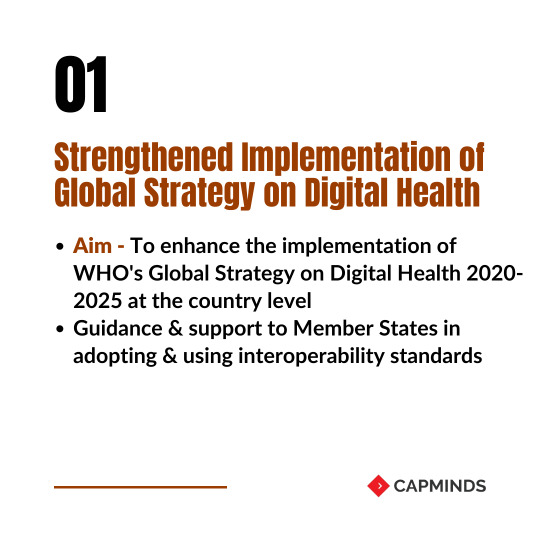

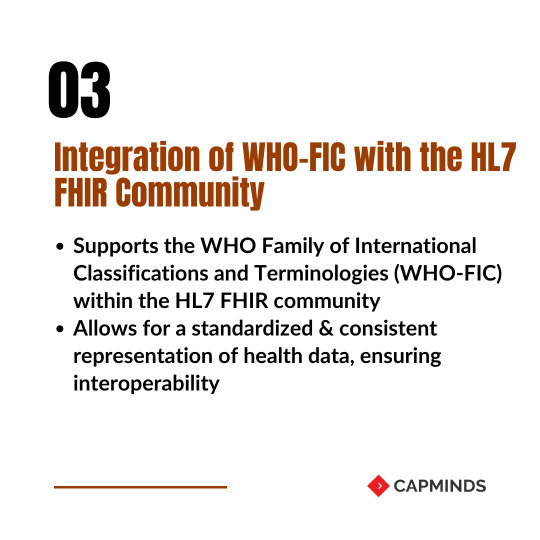
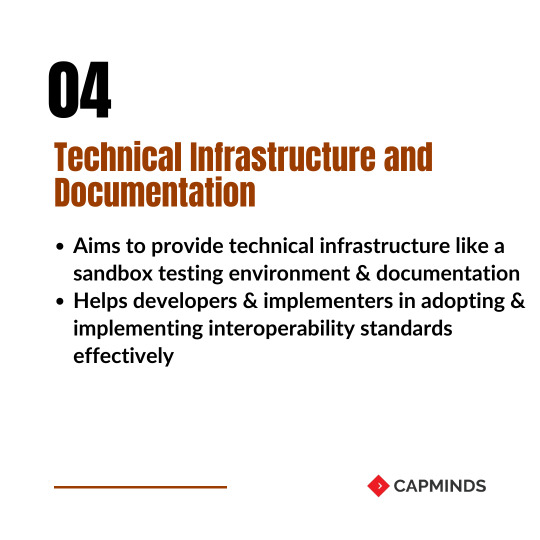
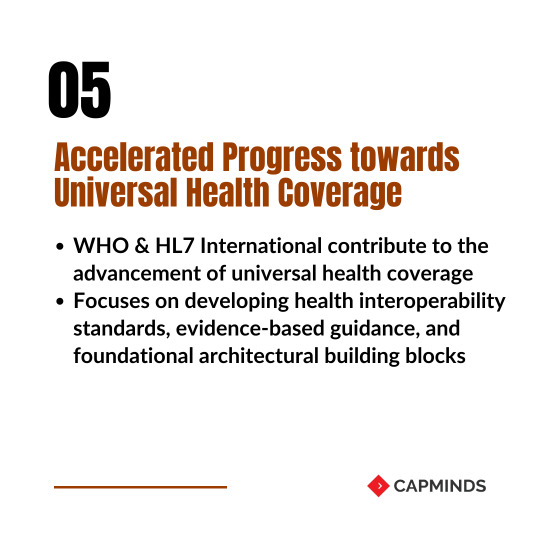

The collaboration between WHO and HL7 International brings together their respective expertise and resources to drive the adoption and appropriate use of interoperability standards globally.
This collaboration has the potential to harmonize digital health systems, improve data exchange and continuity of care, and contribute to the overall goal of achieving universal health coverage.
2 notes
·
View notes
Text
FHIR Server Fusion: Advanced Healthcare Interoperability Solution for Seamless Data Exchange
Helixbeat’s FHIR Server Fusion enables secure, standardized healthcare data exchange across systems. Enhance interoperability, improve patient care, and streamline clinical workflows with this scalable and efficient healthcare interoperability solution built on FHIR standards.
#healthcare interoperability solution#FHIR compliant interoperability software#healthcare interoperability platforms#hl7 platform
0 notes